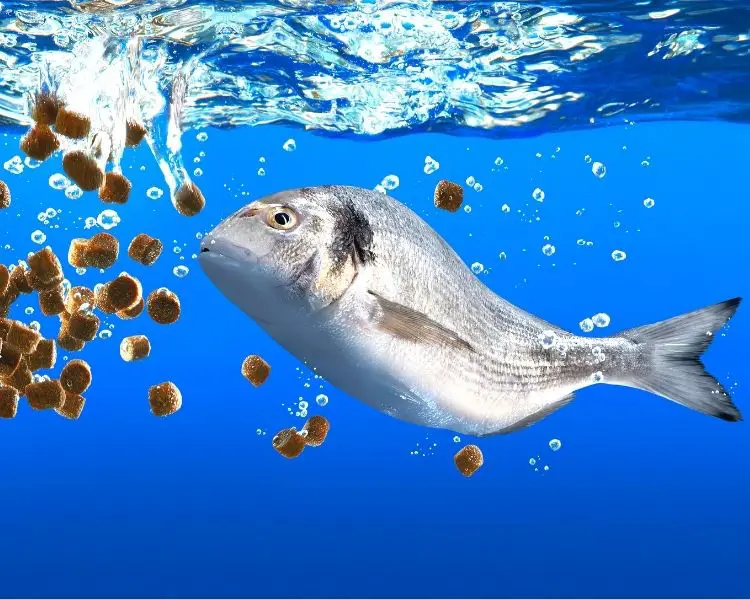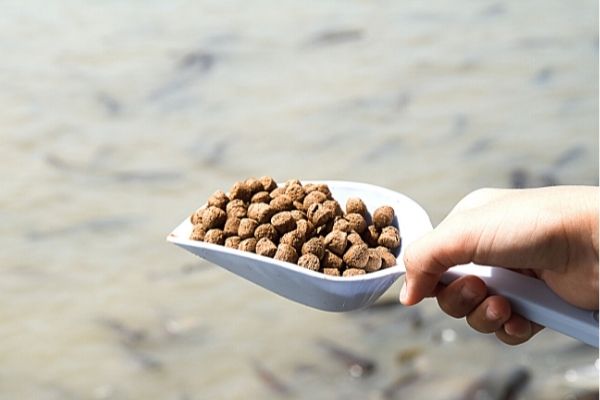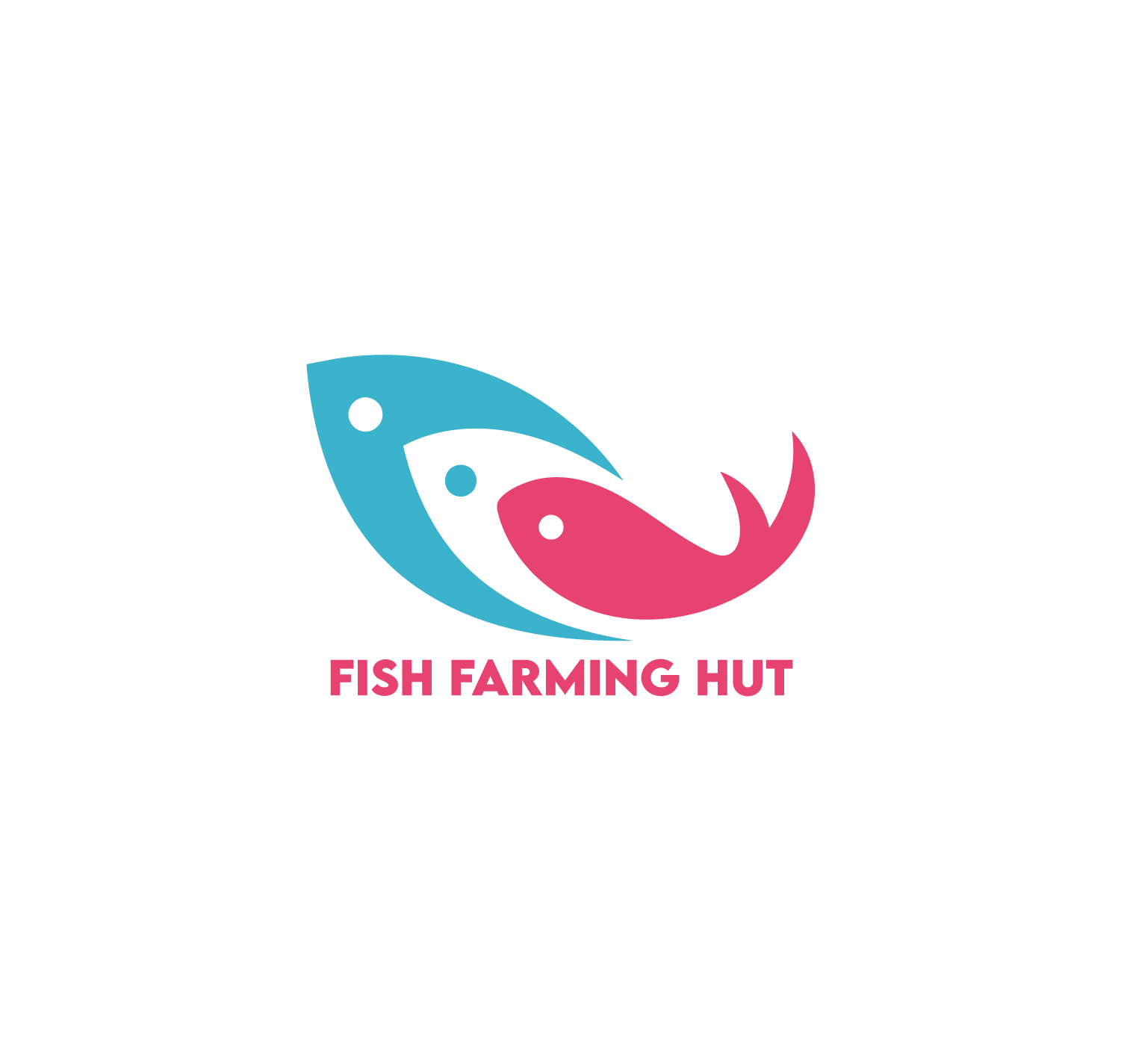Fish feeding methods have a massive impact on production efficiency. Before you select a fish feeding practice for your farm, you must consider the life stage of your fish, impact on fish metabolism due to variations in water temperature, the characteristics of your culture system, and the ease of access to the feeds.
There’s no one recognized fish feeding method. That said, you’ll find some general principles you should adhere to whenever possible.
Based on your system of production, the type of fish feeding system can be defined as:

Commercially Produced Feeds
These types of prepared or artificial feeds consist of complete or supplemental formulations. A complete diet will supply your fish with all the ingredients they need for optimal growth and health, including proteins, carbohydrates, vitamins, essential minerals, and fats.
Species of fish and their life stages determine the nutritional content demands. Raising fish in high-density indoor systems or cages limits free foraging for natural foods like algae, aquatic plants, aquatic invertebrates—meaning you have to provide them with a complete diet.
On the other hand, the supplemental feeding method supports the natural food available to fish in either ponds or raceway systems. These incomplete or partial feed diets do not provide a full complement of needed vitamins or essential minerals. Typically, supplemental diets help fortify the available diet in the system by providing additional proteins, carbohydrates, and lipids.
Which Fish Feed Should I Choose: Floating or Sinking?
Commercial feed diets can be classified into;
Either one of the above feeds ought to produce favorable growth, but you’ll find some fish species will have a preference for floating feeds and others sinking. Even so, most fish species will accept floating pellets with training.
- Complete and balanced nutrition - Ideal for a variety of fish species
- Evaluate the health of your fish and ensure the correct feeding amount - Floating particles help bring your fish to the surface. This allows you to evaluate their size and health and make sure you are not over- or under-feeding them.
- Feeds a wide variety of fish species and sizes - By providing various particle sizes, your fish are sure to find one that will fit the size of their mouth. This allows you to provide top nutrition for the many types, sizes and ages of fish in your water - all with the same bag of feed.
- Fish meal and an attractant - High palatability for quick, consistent feed consumption. Strong Fish attract.
- Floating diet - Makes it easy to visually manage feeding - less waste and designed to improve water quality
There’s an advantage to feeding your fish with extruded (floating/buoyant) feeds. Here’s why.
Extruded feeds allow you to observe your fish’s feeding intensity, and thereby, you can adjust the feeding rates. This strategy is key to maximizing fish growth while limiting wastage through feed use efficiency.

Pellet fish feed
Floating feeds come in various sizes, starting from fine crumbles to large pellets depending on the size of your fish. On average, the pellet size ought to be around 20-30% of the fish’s mouth gape.
Too small a pellet for your fish results inefficient feeding—in this case, the fish will use more energy to find and eat more pellets. Similarly, sizeable pellets can depress feeding or, in extreme incidents, cause choking. Pick the largest-sized pellet your fish can actively eat to minimize such concerns. Most feed manufacturers will often provide a guide matching the pellet size to fish species and life stage.
- Ideal for bottom dwelling fish
- Nutritious food ingredients that fish are naturally attracted to
- Formulated so that fish utilize more of what they eat and create less waste
- Supports a healthy immune system, brings out their true colors and provides the essentials for proper growth and vitality
- Will not cloud water when fed as directed
Rate of Feeding, Frequency, & Timing
The amount and how often you feed your fish mainly depends on fish size. Fish fry and larval fish need a regular high-protein diet (often in excess). These fish stages have a high energy demand. For this reason, the fish tend to eat almost continuously.
As your fish grow, reduce the feeding rates, frequency, and protein content. But instead of opting for a lower protein diet, it’d be best to feed less. This strategy allows you to use the same feed during the grow-out period, and as such, you get to simplify your feed inventory and storage.
Feeding your fish is a labor-intensive and costly activity for a large-scale grower. How frequently you feed your fish depends on several factors, including labor availability, farm size, production system, and fish sizes.
Due to time and labor limitations, larger farms with multiple ponds may feed their fish only once. Other smaller farms may have the ability to feed twice daily.
Primarily, growth and feed conversion improve with feeding frequency. That’s why you may find growers who invest in indoor intensive production systems feeding their fish five times a day to maximize growth at regulated temperatures.
Other factors affecting fish feeding rates include;
Feeding your fish in a pond setting in the early morning is not a smart move since the low dissolved oxygen levels will be a concern. On the flip side, such issues don’t arise in a recirculating aquaculture production system where oxygen is regularly supplied.
During the cold winter seasons (when the water temperature is low), you should reduce the frequency rates you feed your warm-water fish in the pond system proportionately.
Bear in mind the feed tolerability, palatability, and digestibility range based on the ingredients and feed quality. As a fish farmer, you’d want to take note of the feeding activity to help you work out the feed acceptance, feed conversion rates, calculate feed efficiency, and monitor feed costs throughout the growth period.
As a rule of thumb, most farmed fish are generally fed 1-5% of their body weight each day.
Now let’s discuss feeding equipment.
Automatic Fish Feeders
Fish Farmers can choose to feed their fish by hand, automatic fish feeders, or demand fish feeders. By feeding your fish by hand, you get to observe their health, feeding enthusiasm, and notable issues relating to the fish. But larger farms don’t have such luxury owing to their size. It’s common to find these farms having feed trucks featuring compressed air blowers that distribute (toss) the feeds uniformly all over the pond.
Automatic (timed) fish feeders come in a range of designs, including belt fish feeders (that make use of wind-up springs), electric vibrating fish feeders, or timed fish feeders (programmed to feed for extended periods)
Demand Fish Feeders
Fish growers can use demand feeders under specific settings. These tools allow the fish to feed whenever they want. A demand fish feeder features a feed storage container designed with a conical-shaped bottom, plus a disc positioned slightly beneath the conical base. A metal rod then sticks out into the water. Feed drops into the water once the fish touch this rod.
A grower can adjust the quantity of feed the rod dispenses. This type of feeding equipment is great for raceway production systems. Demand feeders don’t use electricity or batteries. Remember to check the demand feeders regularly to ensure they’re working as they should, plus to refill the feed.
Automatic and demand feeders will save the grower time, labor, and money, but these benefits come at the expense of the vigilance hand-feeding avails.
Feed Blower
Optimal distribution of feeds is a key consideration in fish production systems. Feed is relatively easier to distribute in smaller-sized aquaculture systems like raceways, cages, net pens, and intensive flow-through or recirculating water production systems.
For large ponds, feed distribution becomes a concern. In such settings, fish farmers often turn to feed blowers mounted/pulled by trucks to dispense feeds in these production systems. Distributing feeds down one side or multiple sides of the pond is a smart move since this step makes sure the feed is accessible to the vast majority of the fish.
Medicated Feeds
This is not a Veterinarian Advice
The Ideas and Strategies presented in this article and the information are based on our research and experience. These strategies are not intended to be a substitute for professional medical advice, diagnosis, or treatment. The information and/or documents contained on this website do not constitute veterinarian or medical advice. You should not disregard, or delay in obtaining, medical advice for any medical condition your fish may have.
Medicated feeds provide an effective way to treat your fish and limit bacterial infections in extensive culture systems. The U.S Food & Drug Administration lists several commercial antibiotic products. These include oxytetracycline, florfenicol, and sulfadimethoxine or ormetoprim for use in the farming of fish suitable for human consumption.
That said, the amount of antibiotics fed to the fish must be controlled. Fish Farmers must adjust feeding rates and regulate withdrawal times to minimize deposition of the antibiotics into the fish tissues. It is also important to limit the release of the medicated feeds into the rearing water discharged into the environment.
Bottom Line
Fish feeding is one of the main expenditures in a fish production system. Managing how, when, and the amounts you feed your fish goes a long way in controlling your overall culture cost and improves the production system’s water quality.
Growers have access to reliable estimates of nutrient requirements for most cultured fish species. The nutritional needs for fish’s healthy and desirable growth are relatively comparable among fish species sharing common natural feeding habits or environmental requirements.
Be sure to check out the recommendations of feed manufacturers for information regarding the nutritional value and the best feedstuffs for particular fish species.
Sources



![[Large Floating Pool Thermometer] eLander Pro Water Thermometers, for Outdoor & Indoor Swimming Pools, Spas, Hot Tubs, Fish Ponds [Large Floating Pool Thermometer] eLander Pro Water Thermometers, for Outdoor & Indoor Swimming Pools, Spas, Hot Tubs, Fish Ponds](https://m.media-amazon.com/images/I/51MDUTrRZWL._SL500_.jpg)
